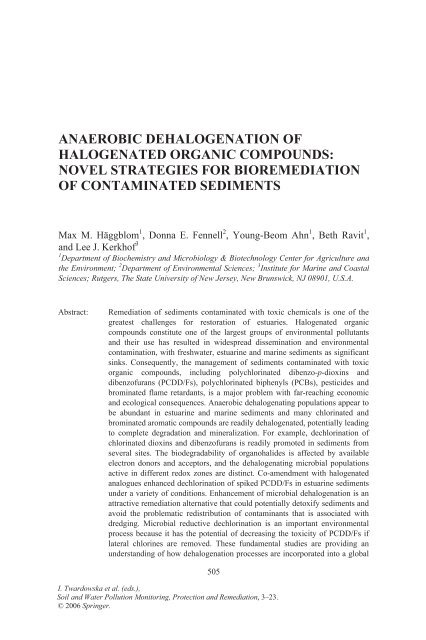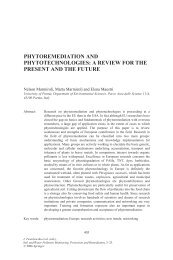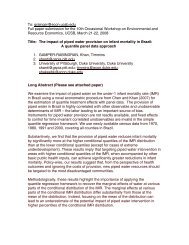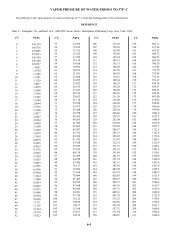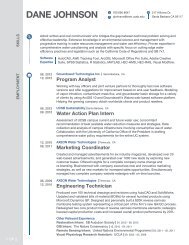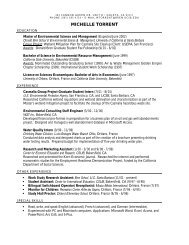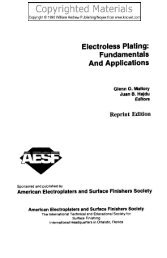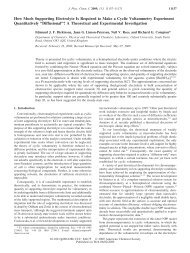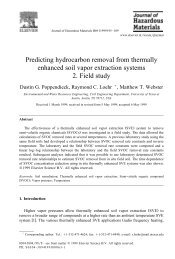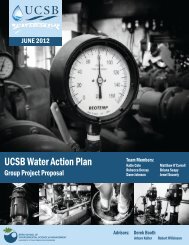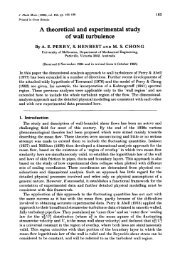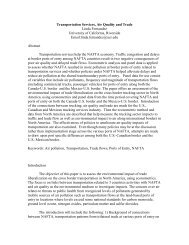anaerobic dehalogenation of halogenated organic compounds
anaerobic dehalogenation of halogenated organic compounds
anaerobic dehalogenation of halogenated organic compounds
Create successful ePaper yourself
Turn your PDF publications into a flip-book with our unique Google optimized e-Paper software.
ANAEROBIC DEHALOGENATION OF<br />
HALOGENATED ORGANIC COMPOUNDS:<br />
NOVEL STRATEGIES FOR BIOREMEDIATION<br />
OF CONTAMINATED SEDIMENTS<br />
Max M. Häggblom 1 , Donna E. Fennell 2 , Young-Beom Ahn 1 , Beth Ravit 1 ,<br />
and Lee J. Kerkh<strong>of</strong> 3<br />
1 Department <strong>of</strong> Biochemistry and Microbiology & Biotechnology Center for Agriculture and<br />
the Environment; 2 Department <strong>of</strong> Environmental Sciences; 3 Institute for Marine and Coastal<br />
Sciences; Rutgers, The State University <strong>of</strong> New Jersey, New Brunswick, NJ 08901, U.S.A.<br />
Abstract:<br />
Remediation <strong>of</strong> sediments contaminated with toxic chemicals is one <strong>of</strong> the<br />
greatest challenges for restoration <strong>of</strong> estuaries. Halogenated <strong>organic</strong><br />
<strong>compounds</strong> constitute one <strong>of</strong> the largest groups <strong>of</strong> environmental pollutants<br />
and their use has resulted in widespread dissemination and environmental<br />
contamination, with freshwater, estuarine and marine sediments as significant<br />
sinks. Consequently, the management <strong>of</strong> sediments contaminated with toxic<br />
<strong>organic</strong> <strong>compounds</strong>, including polychlorinated dibenzo-p-dioxins and<br />
dibenz<strong>of</strong>urans (PCDD/Fs), polychlorinated biphenyls (PCBs), pesticides and<br />
brominated flame retardants, is a major problem with far-reaching economic<br />
and ecological consequences. Anaerobic dehalogenating populations appear to<br />
be abundant in estuarine and marine sediments and many chlorinated and<br />
brominated aromatic <strong>compounds</strong> are readily de<strong>halogenated</strong>, potentially leading<br />
to complete degradation and mineralization. For example, dechlorination <strong>of</strong><br />
chlorinated dioxins and dibenz<strong>of</strong>urans is readily promoted in sediments from<br />
several sites. The biodegradability <strong>of</strong> organohalides is affected by available<br />
electron donors and acceptors, and the dehalogenating microbial populations<br />
active in different redox zones are distinct. Co-amendment with <strong>halogenated</strong><br />
analogues enhanced dechlorination <strong>of</strong> spiked PCDD/Fs in estuarine sediments<br />
under a variety <strong>of</strong> conditions. Enhancement <strong>of</strong> microbial <strong>dehalogenation</strong> is an<br />
attractive remediation alternative that could potentially detoxify sediments and<br />
avoid the problematic redistribution <strong>of</strong> contaminants that is associated with<br />
dredging. Microbial reductive dechlorination is an important environmental<br />
process because it has the potential <strong>of</strong> decreasing the toxicity <strong>of</strong> PCDD/Fs if<br />
lateral chlorines are removed. These fundamental studies are providing an<br />
understanding <strong>of</strong> how <strong>dehalogenation</strong> processes are incorporated into a global<br />
505<br />
I. Twardowska et al. (eds.),<br />
Soil and Water Pollution Monitoring, Protection and Remediation, 3–23.<br />
© 2006 Springer.
506 Max M. Häggblom et al.<br />
“halogen cycle” and are serving as a base for developing new methods for<br />
bioremediation <strong>of</strong> contaminated sediments.<br />
Key words:<br />
organohalide pollutants; contaminated sediments; <strong>anaerobic</strong> <strong>dehalogenation</strong>;<br />
polychlorinated dibenzo-p-dioxins; <strong>halogenated</strong> flame retardants<br />
1. INTRODUCTION<br />
Remediation <strong>of</strong> sediments contaminated with toxic chemicals is one <strong>of</strong> the<br />
greatest challenges when restoring estuaries and coastal salt marshes.<br />
Halogenated <strong>organic</strong> <strong>compounds</strong> constitute one <strong>of</strong> the largest and most<br />
problematic groups <strong>of</strong> environmental pollutants. These <strong>compounds</strong> are<br />
integral to a variety <strong>of</strong> industrial applications, including use as solvents,<br />
degreasing agents, biocides, pharmaceuticals, plasticizers, hydraulic and heat<br />
transfer fluids, intermediates for chemical synthesis, flame retardants and<br />
numerous other industrial functions. The majority <strong>of</strong> these <strong>compounds</strong> are<br />
chlorinated, but brominated, fluorinated and iodinated <strong>compounds</strong> are also<br />
used in industrial applications (Häggblom and Bossert, 2003). Their use has<br />
resulted in widespread dissemination and environmental contamination, with<br />
estuarine and marine sediments as significant sinks. Consequently, the<br />
management <strong>of</strong> marine and estuarine sediments contaminated with toxic<br />
<strong>organic</strong> <strong>compounds</strong>, including polychlorinated dibenzo-p-dioxins and<br />
dibenz<strong>of</strong>urans (PCDD/Fs), PCBs, pesticides and brominated flame<br />
retardants, is a major problem with far-reaching economic and ecological<br />
consequences.<br />
Microbial degradation is one <strong>of</strong> the key factors that determines the<br />
ultimate fate <strong>of</strong> organohalides in the environment, with cleavage <strong>of</strong> the<br />
carbon-halogen bond being one <strong>of</strong> the critical steps. Microbial degradation<br />
requires the presence <strong>of</strong> enzymes that cleave this bond under physiological<br />
conditions and microorganisms have evolved a variety <strong>of</strong> metabolic<br />
strategies for cleaving the carbon-halogen bond (for reviews, see Häggblom,<br />
1992; Häggblom and Bossert, 2003; Holliger et al., 2003; Löffler et al.,<br />
2003). Dehalogenation reactions comprise different strategies, where<br />
organohalides serve either as electron donors (and carbon sources) or as<br />
electron acceptors. In <strong>anaerobic</strong> sediments the most important process is one<br />
in which the organohalide serves as an alternate electron acceptor for<br />
<strong>anaerobic</strong> respiration, termed dehalorespiration. Microbial degradation <strong>of</strong><br />
organohalides in anoxic sediments is widely observed (Häggblom et al.,<br />
2000, 2003), although the availability <strong>of</strong> suitable electron donors and<br />
acceptors affects the biodegradability <strong>of</strong> organohalides. Anaerobic
Anaerobic Dehalogenation <strong>of</strong> Halogenated Organic Compounds<br />
507<br />
<strong>dehalogenation</strong> is influenced by the microbial communities active in<br />
different redox zones.<br />
Enhancement <strong>of</strong> microbial <strong>dehalogenation</strong> is an attractive remediation<br />
alternative that could potentially detoxify sediments. Furthermore,<br />
remediation <strong>of</strong> organohalide-contaminated sediments in situ could avoid the<br />
problematic redistribution <strong>of</strong> contaminants that is associated with dredging<br />
and would decrease the cost <strong>of</strong> sediment management. However, application<br />
<strong>of</strong> in situ bioremediation <strong>of</strong> organohalide-contaminated marine and estuarine<br />
sediments has been limited by lack <strong>of</strong> fundamental knowledge about the<br />
microorganisms responsible for contaminant degradation, including<br />
<strong>anaerobic</strong> reductive <strong>dehalogenation</strong>, the first step required for the ultimate<br />
complete degradation <strong>of</strong> highly <strong>halogenated</strong> <strong>compounds</strong>. Application <strong>of</strong><br />
bioremediation to organohalide-contaminated sediments is also limited by<br />
the low bioavailability <strong>of</strong> these <strong>compounds</strong> and the inability to effectively<br />
stimulate biodegradation. The lack <strong>of</strong> knowledge about the microorganisms<br />
responsible for <strong>dehalogenation</strong> <strong>of</strong> PCDD/Fs and PCBs in particular, also<br />
presents a limit on engineered manipulation <strong>of</strong> estuarine sediments. Detailed<br />
information on the <strong>dehalogenation</strong> process is needed to provide strategies for<br />
remediation <strong>of</strong> contaminated sediments by enhancing <strong>dehalogenation</strong> <strong>of</strong><br />
organohalogen pollutants in situ and/or in conjunction with sediment caps.<br />
2. IDENTIFICATION OF DEHALOGENATING<br />
POPULATIONS IN MARINE SEDIMENTS<br />
Microbial degradation <strong>of</strong> organohalides in anoxic sediments is widely<br />
observed. In marine and estuarine sediments the interactions with other<br />
competing respiratory electron acceptors will have a direct impact on the<br />
activity <strong>of</strong> the microbial community and biodegradability <strong>of</strong> organohalide<br />
<strong>compounds</strong> (Bossert et al., 2003; Häggblom et al., 2003). The prevailing<br />
electron accepting processes that participate in <strong>dehalogenation</strong> are<br />
determined not only by the availability <strong>of</strong> electron accepting species, but<br />
also by the concentration <strong>of</strong> electron donors, especially hydrogen, in the<br />
environment (Fennell and Gossett, 1998, 2003). Competition for hydrogen<br />
(or other simple <strong>organic</strong> electron donors) is key in determining the<br />
succession <strong>of</strong> microorganisms and redox processes.<br />
Reductive <strong>dehalogenation</strong> can proceed simultaneously with other<br />
dominant electron-accepting processes, with further degradation <strong>of</strong> the<br />
de<strong>halogenated</strong> product coupled to methanogenesis, sulfate reduction, or<br />
iron(III) reduction (Steward et al., 1995; Häggblom, 1998; Häggblom et al.,<br />
1993; Häggblom and Young, 1995; Boyle et al., 1999a, 1999b; Knight et al.,<br />
1999, 2003; Monserrate and Häggblom, 1997; Sun et al., 2000, 2001). The
508 Max M. Häggblom et al.<br />
dehalogenating populations are distinct under different redox conditions,<br />
e.g., sulfidogenic, iron-reducing or methanogenic (Knight et al., 1999;<br />
Häggblom et al., 2000; Rhee et al., 2003; Fennell et al., 2004a). Differences<br />
in substrate specificity, differences in apparent rate <strong>of</strong> <strong>dehalogenation</strong>, and<br />
unique community pr<strong>of</strong>iles indicate that distinct microbial populations are<br />
responsible for reductive <strong>dehalogenation</strong> under different dominant terminal<br />
electron accepting conditions (Knight et al., 1999; Häggblom et al., 2000,<br />
2003).<br />
A.<br />
181 bp<br />
215 bp<br />
DNA: 2<br />
-BP + Sulfate master culture<br />
B.<br />
215 bp<br />
224 bp<br />
RNA: Phenol + Sulfate<br />
254 bp 298 bp<br />
C.<br />
181 bp<br />
212 bp<br />
RNA: 2<br />
-BP + Hydrogen<br />
D.<br />
181 bp<br />
DNA: Cloned SSU gene<br />
2-BP 48<br />
Figure 1. Comparison <strong>of</strong> T-RFLP analysis <strong>of</strong> genomic DNA from master culture 16S rRNA<br />
gene (A), reverse transcribed 16S rRNA from knock-out cultures phenol + sulfate (B), 2-<br />
bromophenol + hydrogen (C) and cloned 16S rRNA gene <strong>of</strong> 2BP-48 (from Fennell et al.,<br />
2004a).<br />
We have pursued the characterization <strong>of</strong> the structure and diversity<br />
<strong>of</strong> microbial food webs that are active during <strong>dehalogenation</strong> in <strong>anaerobic</strong><br />
estuarine and marine sediments in order to identify the dehalogenating<br />
organisms. We have applied an assay using a starved consortium (low<br />
ribosome content culture) fed a suite <strong>of</strong> selective substrates (Fennell et al.,<br />
2004a). The newly synthesized 16S rRNA was then analyzed using terminalrestriction<br />
fragment length polymorphism (T-RFLP) analysis <strong>of</strong> reverse<br />
transcribed rRNA as a means for assigning a metabolic role to the different<br />
members <strong>of</strong> the sulfidogenic 2-bromo-phenol-dehalogenating consortium.<br />
Those organisms that became active after substrate feeding were recognized<br />
as distinct peaks in the electropherogram and could be identified based on<br />
data from clonal libraries. Direct terminal restriction fragment length<br />
polymorphism fingerprinting <strong>of</strong> ribosomes in the various subcultures (fed
Anaerobic Dehalogenation <strong>of</strong> Halogenated Organic Compounds<br />
509<br />
different substrate combinations) indicated that phylotype 2BP-48 (a<br />
Desulfovibrio-like sequence reported previously; Knight et al., 1999) was<br />
responsible for the <strong>dehalogenation</strong> <strong>of</strong> 2-bromophenol (Figure 1). A stable coculture<br />
was established containing predominantly 2BP-48 and a second<br />
Desulfovibrio species capable <strong>of</strong> mineralizing 2-bromophenol coupled to<br />
sulfate reduction. Strain 2BP-48 in the co-culture could couple reductive<br />
<strong>dehalogenation</strong> to growth with 2-bromophenol, 2,6-dibromophenol, or 2-<br />
iodophenol with lactate or formate as an electron donor. Interestingly, this<br />
strain is capable <strong>of</strong> simultaneous sulfidogenesis and reductive<br />
<strong>dehalogenation</strong> in the presence <strong>of</strong> sulfate.<br />
The use <strong>of</strong> functional genes (Rhee et al., 2003) to elucidate<br />
dehalogenating microorganisms in consortia or natural environments is an<br />
alternative to the indirect method using ribosomes. Recently, several<br />
membrane bound reductive dehalogenases (RDH) have been purified and<br />
characterized (see Holliger et al., 2003). Several sets <strong>of</strong> degenerate PCR<br />
primers to amplify RDH gene fragments were designed and putative RDH<br />
genes were cloned and identified from estuarine and marine environments<br />
(Rhee et al., 2003; Ahn et al., 2003, unpublished; Figure 2).<br />
The amino acid sequences deduced from the C-terminal region <strong>of</strong> the<br />
enzymes were compared and showed high similarity. However, several <strong>of</strong><br />
these putative RDH genes were linked to transposon-like sequences and<br />
may, in fact, be pseudogenes (Rhee et al., 2003). Thus, additional assays<br />
must be done at the mRNA level to identify expressed RDH genes in natural<br />
samples in order to monitor dehalogenating populations.<br />
We have used 1,2,3,4-tetrachlorodibenzo-p-dioxin (1,2,3,4-TeCDD) and<br />
1,2,3,4-tetrachlorodibenz<strong>of</strong>uran (1,2,3,4-TeCDF) as model contaminants to<br />
examine the potential for microbial reductive dechlorination <strong>of</strong> PCDD/Fs<br />
and to develop highly enriched cultures for determination <strong>of</strong> the identities <strong>of</strong><br />
the dechlorinating organisms (Vargas et al., 2001; Fennell et al., 2004b; Ahn<br />
et al., 2005). We have characterized the PCDD/F dechlorinating capability <strong>of</strong><br />
native dehalogenating bacteria from using a variety <strong>of</strong> electron donor and<br />
<strong>halogenated</strong> co-amendments (Ahn et al., 2005). PCDD dechlorination was<br />
observed in different freshwater, estuarine and marine sediments, suggesting<br />
the ubiquitous nature <strong>of</strong> these bacteria. 1,2,3,4-TeCDD was sequentially<br />
de<strong>halogenated</strong>, initially in the lateral position, leading to the formation <strong>of</strong> 2-<br />
monoCDD (Figure 3.) While reductive dechlorination <strong>of</strong> PCDDs occured in<br />
sulfate-rich environments, the rates <strong>of</strong> dechlorination were slower than those<br />
under methanogenic conditions. The pathways may also be different,<br />
possibly indicating the stimulation <strong>of</strong> phylogenetically different organisms<br />
(Ahn et al., unpublished). There have been many reports that the presence <strong>of</strong>
Mole %<br />
510 Max M. Häggblom et al.<br />
rdh61<br />
rdh63<br />
Dehalococcoides ethenogenes (Tce A)<br />
Dehalococcoides sp. VS<br />
Desulfitobacterium hafniense (CprA)<br />
Paleta creek2<br />
Paleta creek1<br />
85<br />
65<br />
Desulfitobacterium dehalogenans (CprA )<br />
63<br />
79<br />
35<br />
Sulfurospirillum<br />
multivorans (PceA)<br />
73<br />
33<br />
97<br />
SpongeE47<br />
Desulfitobacterium sp. Y51 (Pce A)<br />
100<br />
100<br />
0.1<br />
rdh81A<br />
E36<br />
E32<br />
E411<br />
Sponge group 2<br />
E42 E34<br />
E41 E310<br />
E29 E37 E45<br />
Sponge group 1<br />
Figure 2. Phylogenetic tree <strong>of</strong> deduced partial amino acid sequences <strong>of</strong> reductive<br />
dehalogenases. Reference bar indicates 10 amino acid exchanges per 100 amino acids.<br />
sulfate inhibits reductive dechlorination <strong>of</strong> PCDDs (Vargas et al., 2001) and<br />
PCBs (Alder et al., 1993; Zwiernik et al., 1998). It is at the same time<br />
interesting to note that some <strong>of</strong> the dehalogenating organisms that have been<br />
characterized are themselves sulfate reducers (DeWeerd et al., 1991; Boyle<br />
et al., 1999c; Ahn et al., unpublished).<br />
100<br />
90<br />
80<br />
70<br />
60<br />
50<br />
40<br />
30<br />
20<br />
10<br />
0<br />
1,2,3,4-TeCDD<br />
1,2,4-TriCDD<br />
1,3-DCDD<br />
2-MCDD<br />
(+) 2BP (-) 2BP (+) Sulfate<br />
(+)2BP<br />
(+) Sulfate<br />
(-)2BP<br />
Figure 3. Mole % 1,2,3,4-TeCDD and its dechlorination daughter products in Paleta Creek<br />
sediment under methanogenic and sulfidogenic conditions with and without the addition <strong>of</strong><br />
2-bromophenol (from Ahn et al., 2005).
Anaerobic Dehalogenation <strong>of</strong> Halogenated Organic Compounds<br />
511<br />
3. DEHALOCOCCOIDES ETHENOGENES<br />
DECHLORINATES DIVERSE CHLORINATED<br />
AROMATIC POLLUTANTS<br />
Dehalococcoides ethenogenes strain 195 dechlorinates tetrachloroethene<br />
to vinyl chloride and ethene and its genome has been found to contain up to<br />
17 dehalogenase gene homologues (Seshadri et al., 2005) suggesting diverse<br />
<strong>dehalogenation</strong> potential. Detection <strong>of</strong> multiple dehalogenase homologs in<br />
other strains (Hölsher et al., 2004) provides further evidence for the<br />
metabolic versatility <strong>of</strong> this phylogenetic group. Within the Chlor<strong>of</strong>lexi,<br />
which includes both Dehalococcoides spp. and other yet to be described<br />
genera, there appears to be several strains with the ability to reductively<br />
dechlorinate PCBs and other <strong>halogenated</strong> <strong>compounds</strong> as electron acceptors<br />
(Wu et al., 2002a; Bunge et al., 2003; Watts et al., 2001; Miller et al., 2005).<br />
We have demonstrated that D. ethenogenes strain 195 has the potential to<br />
dechlorinate many different types <strong>of</strong> chlorinated aromatic <strong>compounds</strong>, in<br />
addition to its known chloroethene respiratory electron acceptors (Fennell et<br />
al., 2004b). D. ethenogenes strain 195 dechlorinated 1,2,3,4- tetrachlorodibenzo-p-dioxin<br />
to a mixture <strong>of</strong> 1,2,4-trichlorodibenzo-p-dioxin and 1,3-<br />
dichlorodibenzo-p-dioxin (Figure 4). 2,3,4,5,6-Pentachlorobiphenyl was<br />
dechlorinated to 2,3,4,6- and/or 2,3,5,6-tetrachlorobiphenyl and 2,4,6-<br />
trichlorobiphenyl. 1,2,3,4-Tetrachloronaphthalene was dechlorinated<br />
primarily to an unidentified dichloronaphthalene congener. Results obtained<br />
after re-amendment <strong>of</strong> cultures with PCE suggest that the <strong>dehalogenation</strong><br />
observed was not necessarily dependent on on-going PCE dehalorespiration<br />
since no concomitant increase in the rate <strong>of</strong> chloroaromatic dechlorination<br />
was observed.<br />
The ability <strong>of</strong> D. ethenogenes strain 195 to dehalogenate such a diverse<br />
array <strong>of</strong> organohalides is significant given the prevalence <strong>of</strong><br />
Dehalococcoides-like organisms in the environment. Bunge et al. (2003)<br />
have shown that Dehalococcoides sp. strain CBDB1, which was originally<br />
cultivated on trichlorobenzene (Adrian et al., 2000), dehalogenates and<br />
sustains growth on chlorinated dioxins. Highly enriched cultures containing<br />
strains DF-1 and o-17, bacteria distantly related to Dehalococcoides, are able<br />
to dehalogenate chlorinated biphenyls (Wu et al., 2002a; Cutter et al., 2001)<br />
and DF-1 also dechlorinates the chlorinated benzenes (Wu et al., 2002b).<br />
Aside from these reports, little is known about the <strong>anaerobic</strong> microorganisms<br />
that mediate reductive dechlorination <strong>of</strong> PCDD/Fs, which is<br />
required to initiate complete degradation <strong>of</strong> highly chlorinated congeners<br />
(Toussaint et al., 1998; Gruden et al., 2003), or how to enhance the growth<br />
<strong>of</strong> these organisms under field conditions. Microbial reductive
Mole Fraction<br />
512 Max M. Häggblom et al.<br />
1.0<br />
0.8<br />
0.6<br />
0.4<br />
0.2<br />
0.0<br />
1.0<br />
0.8<br />
0.6<br />
0.4<br />
0.2<br />
0.0<br />
1.0<br />
0.8<br />
0.6<br />
0.4<br />
0.2<br />
0.0<br />
A<br />
1,2,3,4 -TeCDD<br />
1,2,4 -TrCDD<br />
1,3 -DCDD<br />
B<br />
1,2,3,4 -TeCDF<br />
TrCDF<br />
2,3,4,5,6 -PeCB<br />
C<br />
2,4,5,6 / 2,3,5,6 -TeCB<br />
2,4,6 -TrCB<br />
0 50 100 150 200 250<br />
Time (Day)<br />
Figure 4. Dechlorination by Dehalococcoides ethenogenes strain 195 <strong>of</strong> (A) 1,2,3,4-<br />
tetrachlorodibenzo-p-dioxin (B,) 1,2,3,4-tetrachlorodibenz<strong>of</strong>uran and (C) 2,3,4,5,6-<br />
pentachlorobiphenyl (from Fennell et al., 2004b).<br />
<strong>dehalogenation</strong> in sediments is an important environmental process because<br />
it has the potential <strong>of</strong> decreasing the toxicity <strong>of</strong> organohalides such as<br />
PCDD/Fs. Dehalogenation may also be advantageous in designing<br />
contaminant treatment trains, since lesser chlorinated congeners are more<br />
susceptible to subsequent aerobic degradation.<br />
4. PRIMING DEHALOGENATION<br />
Recent research, including our own (Vargas et al., 2001; Fennell et al.,<br />
2004a; Ahn et al., 2005), has shown the potential for stimulation <strong>of</strong><br />
dechlorination <strong>of</strong> <strong>halogenated</strong> <strong>organic</strong>s in sediments under a variety <strong>of</strong><br />
conditions. Biostimulation may be achieved through the addition <strong>of</strong> electron<br />
donors and/or <strong>of</strong> <strong>halogenated</strong> co-amendments that serve as more bioavailable<br />
electron acceptors.<br />
Hydrogen is used by many dehalogenating bacteria and has also been<br />
shown to enhance dechlorination <strong>of</strong> PCDD residues in contaminated<br />
sediments (Albrecht et al., 1999). Hydrogen can be supplied directly or
Anaerobic Dehalogenation <strong>of</strong> Halogenated Organic Compounds<br />
513<br />
indirectly, at different biologically maintained levels, through the addition <strong>of</strong><br />
fermentable <strong>organic</strong> <strong>compounds</strong> that serve as hydrogen donors (Fennell et<br />
al., 1997; Fennell and Gossett 2003; Yang and McCarty, 1998). In strict<br />
competition for hydrogen, dehalogenating bacteria can out-compete sulfate<br />
reducers. For example, the hydrogen threshold achieved by tetrachloroethene-dechlorinating<br />
populations in estuarine sediments was 0.5 nmol, less<br />
than that <strong>of</strong> the hydrogen level achieved by sulfate reduction in the same<br />
system (Mazur and Jones, 2001). Löffler et al., (1999) provided clear<br />
evidence for the role <strong>of</strong> hydrogen threshold concentrations in determination<br />
<strong>of</strong> electron accepting processes, also showed that thermodynamic<br />
constraints, i.e., uptake and energy yield, favor utilization by dehalorespirers<br />
in the presence <strong>of</strong> organohalide substrates. Clearly, all <strong>of</strong> these factors are<br />
important to consider when attempting to stimulate <strong>dehalogenation</strong> in situ.<br />
The addition <strong>of</strong> alternate <strong>halogenated</strong> <strong>compounds</strong>, referred to as<br />
"priming" agents, has previously been shown to enhance dechlorination <strong>of</strong><br />
PCBs and PCDDs (Beurskens et al., 1995; DeWeerd and Bedard 1999;<br />
Albrecht et al., 1999; Cho et al., 2002). For example, brominated <strong>compounds</strong><br />
stimulated the dechlorination <strong>of</strong> PCBs in freshwater sediments (Bedard et<br />
al., 1998; DeWeerd and Bedard, 1999), monobromo-dibenzo-p-dioxin<br />
stimulated dechlorination <strong>of</strong> historically contaminated PCDDs (Albrecht<br />
et al., 1999), and bromophenols stimulated dechlorination <strong>of</strong> PCDDs in<br />
estuarine sediments (Vargas et al., 2001). This approach has been used with<br />
some success in small scale field studies (Bedard, 2003).<br />
We previously demonstrated that dechlorination <strong>of</strong> 1,2,3,4-TeCDD was<br />
more extensive in heavily contaminated estuarine sediments from the Arthur<br />
Kill, an estuarine inlet located between Staten Island, New York and New<br />
Jersey, USA, when pre-enrichment on bromophenols was performed (Vargas<br />
et al., 2001). Bromophenol also stimulated 1,2,3,4-TeCDD dechlorination in<br />
sediments from San Diego Bay under methanogenic and sulfidogenic<br />
conditions (Ahn et al., 2005; Figure 3). We hypothesized that co-amendment<br />
<strong>of</strong> <strong>halogenated</strong> <strong>compounds</strong> with greater structural similarity to PCDD/Fs<br />
would be more effective at stimulating dechlorination <strong>of</strong> PCDD/Fs than<br />
simpler <strong>halogenated</strong> substrates such as bromophenols. Also, PCDD<br />
dechlorination should be more easily stimulated in sediment previously<br />
contaminated with other chlorinated <strong>compounds</strong> than in pristine sediments.<br />
Further investigation demonstrated that the most effective stimulation<br />
<strong>of</strong> 1,2,3,4-TeCDD and 1,2,3,4-TeCDF dechlorination occurred with<br />
co-amendment <strong>of</strong> 25 M <strong>of</strong> 1,2,3,4-tetrachlorobenzene (TeCB), 2,3,4,5-<br />
tetrachloroanisole (TeCA), 2,3,4,5-tetrachlorophenol or 2',3',4'-trichloroacetophenone<br />
as substrate analogs plus 500 M lactate and 500 M<br />
propionate as electron donors (Ahn et al., 2005; Figure 5).
Mol %<br />
Mol %<br />
Auto<br />
Live<br />
TeCB<br />
TeCA<br />
TeCP<br />
TeCBA<br />
TrCAP<br />
Lac/Pro<br />
Mol %<br />
514 Max M. Häggblom et al.<br />
100<br />
90<br />
80<br />
70<br />
60<br />
50<br />
40<br />
30<br />
20<br />
10<br />
0<br />
A<br />
100<br />
90<br />
80<br />
70<br />
60<br />
50<br />
40<br />
30<br />
20<br />
10<br />
0<br />
100<br />
90<br />
80<br />
70<br />
60<br />
50<br />
40<br />
30<br />
20<br />
10<br />
0<br />
B<br />
0 2 4 6 8 10<br />
Control<br />
1,2,3,4-TCDD<br />
1,2,4-TCDD<br />
1,3-DCDD<br />
2-MCDD<br />
Time (months)<br />
C<br />
0 2 4 6 8 10<br />
Time (months)<br />
Figure 5. 1,2,3,4-TeCDD dechlorination in Paleta Creek sediment slurries under different<br />
electron donor and <strong>halogenated</strong> co-amendment conditions over 10 months with a 3-month reamendment<br />
interval (A) Mole percent <strong>of</strong> 1,2,3,4-TeCDD remaining after 15 months; (B) time<br />
course <strong>of</strong> 1,2,3,4-TeCDD dechlorination in TeCB plus lactate/propionate-amended slurries<br />
and (C) time course <strong>of</strong> 1,2,3,4-TeCDD dechlorination in TeCA plus lactate/propionateamended<br />
slurries (Ahn et al., 2005).<br />
Similarly, dechlorination <strong>of</strong> 1,2,3,4-TeCDF to tri-chlorinated and dichlorinated<br />
daughter products was significantly enhanced by TeCB and<br />
TeCA. These results suggest that <strong>halogenated</strong> aromatic <strong>compounds</strong> with<br />
structural similarity to 1,2,3,4-TeCDD/F stimulate bacteria with the ability to<br />
dechlorinate chlorinated dibenzo-p-dioxin and furans. Of critical importance<br />
is that these amendments stimulate the desirable lateral dechlorination <strong>of</strong><br />
PCDD/Fs (removal <strong>of</strong> chlorines at position 2 and 3) that ultimately results in
Anaerobic Dehalogenation <strong>of</strong> Halogenated Organic Compounds<br />
515<br />
detoxification. This study coupled with findings that some species <strong>of</strong><br />
dehalogenating bacteria have multiple dehalogenases and dechlorination<br />
capabilities suggests that <strong>halogenated</strong> <strong>compounds</strong> other than CDD/Fs could<br />
be used to enrich and isolate organisms that have activity on CDD/Fs.<br />
Identification <strong>of</strong> naturally-occurring or less toxic <strong>halogenated</strong> coamendments<br />
that are completely degraded in the sediment environment is<br />
desirable for field application.<br />
5. DEHALOGENATION IN THE RHIZOSPHERE OF<br />
SALTMARSH PLANTS<br />
An additional variable affecting contaminant degradation in estuarine<br />
ecosystems is the effect <strong>of</strong> wetland plants. Microbial activity is stimulated in<br />
the rhizosphere <strong>of</strong> plants and wetlands may play an important function in<br />
remediation <strong>of</strong> contaminated sites, potentially reducing the impact <strong>of</strong><br />
contaminants. We have examined the effect <strong>of</strong> two salt marsh macrophyte<br />
species on the sediment microbial community responsible for the<br />
biotransformation <strong>of</strong> the flame retardant tetrabromobisphenol A (TBBPA)<br />
(Ravit et al., 2005). Sediments vegetated by two grasses, Spartina<br />
alterniflora and Phragmites australis, commonly found in eastern U.S.<br />
brackish marshes differed significantly in their capacity to biotransform the<br />
<strong>halogenated</strong> contaminant TBBPA. Differences in the rates <strong>of</strong> TBBPA<br />
<strong>dehalogenation</strong> suggests that there are functional differences in sediment<br />
microbial communities in vegetated versus unvegetated habitats, as well as<br />
differences in the microbial communities associated with Spartina and<br />
Phragmites rhizosphere sediments.<br />
The final product <strong>of</strong> microbial reductive <strong>dehalogenation</strong> <strong>of</strong> TBBPA<br />
(Voordeckers et al., 2002; Figure 6) is bisphenol A (4,4'-isopropylidenediphenol),<br />
a known endocrine disrupter. We have not observed<br />
further <strong>anaerobic</strong> degradation <strong>of</strong> bisphenol A (Voordeckers et al., 2002).<br />
Microbial community diversity as measured by in situ sediment<br />
phospholipid fatty acid (PLFA) composition prior to TBBPA exposure, was<br />
found to be higher in the uncontaminated sediments; differences in microbial<br />
PLFA diversity were not seen in contaminated sediments associated with<br />
either the different plant species or unvegetated sediment. Understanding the<br />
effect estuarine vegetation has on dehalogenating microbial populations is<br />
necessary to predict the fate <strong>of</strong> TBBPA, as well as the production and<br />
accumulation <strong>of</strong> bisphenol in estuarine sediments
516 Max M. Häggblom et al.<br />
HO<br />
Br<br />
CH 3<br />
Br<br />
OH<br />
HO<br />
CH 3<br />
OH<br />
Br<br />
CH 3<br />
Br<br />
CH 3<br />
Methanogenic<br />
4 Br - Time (Days)<br />
Sulfidogenic<br />
300<br />
300<br />
250<br />
200<br />
200<br />
150<br />
TBBPA<br />
TBBPA<br />
TBBPA (Sterile)<br />
Conc. (µM)<br />
100<br />
50<br />
TBBPA (sterile)<br />
BPA<br />
Conc. (uM)<br />
100<br />
BPA (TBBPA)<br />
0<br />
0 20 40 60 80 100 120<br />
Time (Days)<br />
0<br />
0 20 40 60 80 100 120<br />
Figure 6. Dehalogenation <strong>of</strong> tetrabromobisphenol A in estuarine microcosms under<br />
methanogenic and sulfidogenic conditions (from Voordeckers et al., 2002).<br />
6. CONCLUSIONS<br />
Reductive <strong>dehalogenation</strong> is a promising mechanism for the removal <strong>of</strong><br />
toxic organohalides from estuarine and marine sediments. Anaerobic<br />
<strong>dehalogenation</strong> <strong>of</strong> <strong>halogenated</strong> aromatic contaminants, such as PCDD/Fs and<br />
tetrabromobipshenol A, was readily promoted in estuarine and marine<br />
sediments from several sites. Co-amendment with more soluble <strong>halogenated</strong><br />
<strong>compounds</strong> as “priming” agents greatly speeds PCDD/F dechlorination in<br />
<strong>anaerobic</strong> sediments. This stimulation was brought about in the presence <strong>of</strong><br />
added electron donors lactate and propionate ensuring reduced conditions<br />
and adequate reducing equivalents to stimulate dechlorination. In highly<br />
<strong>organic</strong> sediments with adequate reducing power, it is possible that these<br />
<strong>halogenated</strong> additives may be just as effective without additional electron<br />
donors. While the process has much potential, a key aspect <strong>of</strong> the technology<br />
– the nature and capability <strong>of</strong> the intrinsic microbial community – is <strong>of</strong>ten<br />
unknown. The use <strong>of</strong> molecular tools for monitoring microbial activity<br />
coupled with the understanding <strong>of</strong> how redox processes affect<br />
<strong>dehalogenation</strong> may be used as a rapid screening method for determining<br />
whether a site is a good candidate for bioremediation and to tailor a<br />
bioremediation strategy for that site.
Anaerobic Dehalogenation <strong>of</strong> Halogenated Organic Compounds<br />
517<br />
Sediment treatment is currently limited primarily to dredging with ex situ<br />
treatment or sequestration. New methods are needed for in situ containment<br />
and degradation <strong>of</strong> contaminants. Contaminated sediments <strong>of</strong>ten contain<br />
complex mixtures <strong>of</strong> pollutants, including PCBs, PCDD/Fs, chlorinated<br />
pesticides, <strong>halogenated</strong> flame retardants, polycyclic aromatic hydrocarbons<br />
(PAHs) and various heavy metals and the challenge <strong>of</strong> remediating the sites<br />
is significant. Our fundamental microbial studies are revealing the potential<br />
for remedial applications in aquatic systems and providing a foundation for<br />
development <strong>of</strong> integrated microbial and engineered approaches to enhance<br />
in situ bioremediation. Anaerobic reductive <strong>dehalogenation</strong> <strong>of</strong>fers the most<br />
promising approach towards eventual detoxification and complete<br />
degradation <strong>of</strong> <strong>halogenated</strong> contaminant mixtures. In situ bioremediation<br />
combined with in-place containment through capping could avoid the<br />
problematic redistribution <strong>of</strong> contaminants that is associated with dredging<br />
and, where feasible, <strong>of</strong>fer a more cost effective treatment alternative to<br />
dredging. Developing amendment technologies for enhanced microbial<br />
<strong>dehalogenation</strong> and understanding how amendment placement and mixing<br />
stimulates <strong>dehalogenation</strong> and impacts the fate and transport <strong>of</strong> organohalide<br />
mixtures is thus a high priority for the successful management <strong>of</strong><br />
contaminated sediments.<br />
ACKNOWLEDGMENTS<br />
Our research on <strong>anaerobic</strong> <strong>dehalogenation</strong> in estuarine and marine<br />
environments has been funded by the Strategic Environmental Research and<br />
Development Program (SERDP) (Grant CU-1208), the Office <strong>of</strong> Naval<br />
Research (Grant N00014-99-0761), the National Science Foundation (Grant<br />
OCE 0451708), the New Jersey Water Resources Research Institute, and the<br />
Meadowlands Environmental Research Institute (MERI).<br />
REFERENCES<br />
Adrian, L., Szewzyk, U., Wecke, J., and Görisch, H., 2000, Bacterial dehalorespiration with<br />
chlorinated benzenes, Nature 408:580–583.<br />
Ahn, Y.-B., Rhee, S.-K., Fennell, D.E., Kerkh<strong>of</strong>, L.J., Hentschel, U., and Häggblom M.M.,<br />
2003, Reductive <strong>dehalogenation</strong> <strong>of</strong> brominated phenolic <strong>compounds</strong> by microorganisms<br />
associated with the marine sponge Aplysina aerophoba, Appl. Environ. Microbiol.<br />
69:4159–4166.<br />
Ahn, Y.-B., Häggblom, M.M., and Fennell, D.E., 2005, Co-amendment with <strong>halogenated</strong><br />
<strong>compounds</strong> enhances <strong>anaerobic</strong> microbial dechlorination <strong>of</strong> 1,2,3,4-tetrachlorodibenzo-pdioxin<br />
and 1,2,3,4-tetrachlorodibenz<strong>of</strong>uran in estuarine sediments, Environ. Toxicol.<br />
Chem. 24:2775–2784.
518 Max M. Häggblom et al.<br />
Albrecht, I.D., Barkovskii, A.L., and Adriaens, P., 1999, Production and dechlorination <strong>of</strong><br />
2,3,7,8-tetrachlorodibenzo-p-dioxin in historically-contaminated estuarine sediments,<br />
Environ. Sci. Technol. 33:737–744.<br />
Alder, A.C., Häggblom, M.M., Oppenheimer, S.R., and Young, L.Y., 1993, Reductive<br />
dechlorination <strong>of</strong> polychlorinated biphenyls in freshwater and marine sediments, Environ.<br />
Sci. Technol. 27:530–538.<br />
Bedard, D.L., 2003, Polychlorinated biphenyls in aquatic sediments: environmental fate and<br />
outlook for biological treatments, In: Dehalogenation: Microbial Processes and<br />
Environmental Applications, M.M. Häggblom and I.D. Bossert, eds, Kluwer Academic<br />
Publishers, Boston, pp. 443–465.<br />
Bedard, D.L., Van Dort, H., and DeWeerd, K.A., 1998, Brominated biphenyls prime<br />
extensive microbial reductive <strong>dehalogenation</strong> <strong>of</strong> Aroclor 1260 in Housatonic River<br />
sediment, Appl Environ Microbiol 64:1786–1795.<br />
Beurskens, J.E.M., Toussaint, M., de Wolf, J., van der Steen, J.M.D., Slot, P.C.,<br />
Commandeur, L.C.M., and Parsons, J.R., 1995, Dehalogenation <strong>of</strong> chlorinated dioxins by<br />
an <strong>anaerobic</strong> microbial consortium from sediment, Environ. Toxicol. Chem. 14:939–943.<br />
Boyle, A.W., Knight, V.K., Häggblom, M.M., and Young, L.Y., 1999a, Transformation <strong>of</strong><br />
2,4-dichlorophenoxyacetic acid in four different marine and estuarine sediments: effects <strong>of</strong><br />
sulfate, hydrogen and acetate on <strong>dehalogenation</strong> and side chain cleavage, FEMS<br />
Microbiol. Ecol. 29:105–113.<br />
Boyle, A.W., Häggblom, M.M., and Young, L.Y., 1999b, Dehalogenation <strong>of</strong> lindane (hexachlorocyclohexane)<br />
by <strong>anaerobic</strong> bacteria from marine sediments and by sulfatereducing<br />
bacteria, FEMS Microbiol. Ecol. 29:379–387.<br />
Boyle, A.W., Phelps, C.D., and Young, L.Y., 1999c, Isolation from estuarine sediments <strong>of</strong> a<br />
Desulfovibrio strain which can grow on lactate coupled to the reductive <strong>dehalogenation</strong> <strong>of</strong><br />
2,4,6-tribromophenol, Appl. Environ. Microbiol. 65:1133–1140.<br />
Bossert, I.D., Häggblom, M.M., and Young, L.Y., 2003 Microbial ecology <strong>of</strong> <strong>dehalogenation</strong>,<br />
In: Dehalogenation: Microbial Processes and Environmental Applications, M.M.<br />
Häggblom and I.D. Bossert, eds, Kluwer Academic Publishers, Boston, pp. 33–52.<br />
Bunge, M., Adrian, L., Kraus, A., Opel, M., Lorenz, W.G., Andreesen, J.R., Görisch, H., and<br />
Lechner, U., 2003 Reductive <strong>dehalogenation</strong> <strong>of</strong> chlorinated dioxins by an <strong>anaerobic</strong><br />
bacterium, Nature 421:357–360.<br />
Cho, Y.-C., Ostr<strong>of</strong>sky, E.B., Sokol, R.C., Frohnhoefer, R.C., and Rhee, G.-Y., 2002,<br />
Enhancement <strong>of</strong> microbial PCB dechlorination by chlorobenzoates, chlorophenols and<br />
chlorobenzenes, FEMS Microbiol. Ecol. 42:51–58.<br />
Cutter, L.A., Watts, J.E.M., Sowers, K.R., and May, H.D., 2001, Identification <strong>of</strong> a bacterium<br />
that links its growth to the reductively dechlorination <strong>of</strong> 2,3,5,6-chlorobiphenyl, Environ.<br />
Microbiol. 3: 699–709.<br />
DeWeerd, K.A., Concannon, F., and Suflita, J.M., 1991. Relationship between hydrogen<br />
consumption, <strong>dehalogenation</strong>, and the reduction <strong>of</strong> sulfur oxyanions by Desulfomonile<br />
tiedjei, Appl. Environ. Microbiol. 57:1929–1934.<br />
DeWeerd, K.A., and Bedard, D.L., 1999, Use <strong>of</strong> <strong>halogenated</strong> benzoates and other <strong>halogenated</strong><br />
aromatic <strong>compounds</strong> to stimulate the microbial dechlorination <strong>of</strong> PCBs, Environ. Sci.<br />
Technol. 33:2057–2063.<br />
Fennell, D.E., Gossett, J.M., and Zinder, S.H., 1997, Comparison <strong>of</strong> butyric acid, ethanol,<br />
lactic acid, and propionic acid as hydrogen donors for the reductive dechlorination <strong>of</strong><br />
tetrachloroethene, Environ. Sci. Technol. 31:918–926.<br />
Fennell, D.E., and Gossett, J.M., 1998, Modeling the production <strong>of</strong> and competition for<br />
hydrogen in a dechlorinating culture, Environ. Sci. Technol. 32:2450–2460.
Anaerobic Dehalogenation <strong>of</strong> Halogenated Organic Compounds<br />
519<br />
Fennell, D.E., and Gossett, J.M., 2003, Microcosms for site-specific evaluation <strong>of</strong> enhanced<br />
biological reductive <strong>dehalogenation</strong>, In: Dehalogenation: Microbial Processes and<br />
Environmental Applications, M.M. Häggblom and I.D. Bossert, eds, Kluwer Academic<br />
Publishers, Boston, pp. 385–420.<br />
Fennell, D.E., Rhee, S.-K., Ahn, Y.-B., Häggblom, M.M., and Kerkh<strong>of</strong>, L.J., 2004a Detecting<br />
the dehalogenating microorganism in a sulfidogenic, 2-bromophenol-utilizing enrichment<br />
by T-RFLP fingerprinting <strong>of</strong> ribosomes, Appl. Environ. Microbiol. 70:1169–1175.<br />
Fennell, D.E., Nijenhuis, I., Wilson, S.F., Zinder, S.H., and Häggblom, M.M., 2004b,<br />
Dehalococcoides ethenogenes strain 195 reductively dechlorinates diverse chlorinated<br />
aromatic pollutants, Environ. Sci. Technol. 38:2075–2081.<br />
Gruden, C.L., Fu, Q.S., Barkovskii, A.L., Albrecht, I.D., Lynam, M.M., and Adriaens, P.,<br />
2003, Dechlorination <strong>of</strong> sediment dioxins: Catalysts, mechanisms, and implications for<br />
remedial strategies and dioxin cycling, In: Dehalogenation: Microbial Processes and<br />
Environmental Applications, M.M. Häggblom and I.D. Bossert, eds, Kluwer Academic<br />
Publishers, Boston, pp. 347–372.<br />
Häggblom, M.M., 1992, Microbial breakdown <strong>of</strong> <strong>halogenated</strong> aromatic pesticides and related<br />
<strong>compounds</strong>, FEMS Microbiol. Rev. 103:29–72.<br />
Häggblom, M.M., 1998, Reductive <strong>dehalogenation</strong> by a sulfate-reducing consortium, FEMS<br />
Microbiol. Ecol. 26:35–41.<br />
Häggblom, M.M., Rivera, M.D., and Young, L.Y., 1993, Influence <strong>of</strong> alternative electron<br />
acceptors on the <strong>anaerobic</strong> biodegradability <strong>of</strong> chlorinated phenols and benzoic acids,<br />
Appl. Environ. Microbiol. 59:1162–1167.<br />
Häggblom M.M., and Young, L.Y., 1995, Anaerobic degradation <strong>of</strong> <strong>halogenated</strong> phenols by<br />
sulfate-reducing consortia, Appl. Environ. Microbiol. 61:1546–1550.<br />
Häggblom, M.M., Knight, V.K., and Kerkh<strong>of</strong>, L.J., 2000, Anaerobic decomposition <strong>of</strong><br />
<strong>halogenated</strong> aromatic <strong>compounds</strong>, Environmental Pollution 107:199–207.<br />
Häggblom, M.M., and Bossert, I.D., 2003 Halogenated <strong>organic</strong> <strong>compounds</strong> - a global<br />
perspective. In: Dehalogenation: Microbial Processes and Environmental Applications,<br />
M.M. Häggblom and I.D. Bossert, eds, Kluwer Academic Publishers, Boston, pp. 3–29.<br />
Häggblom, M.M., Ahn, Y.-B., Fennell, D.E., Kerkh<strong>of</strong>, L.J., and Rhee, S.K., 2003. Anaerobic<br />
<strong>dehalogenation</strong> <strong>of</strong> organohalide contaminants in the marine environment, In: Advances in<br />
Applied Microbiology, A.I. Laskin, G.M. Gadd, and J. Bennett, eds, Elsevier Science, San<br />
Diego, 53:61–84.<br />
Holliger, C., Regeard, C., and Diekert, G., 2003, Dehalogenation by <strong>anaerobic</strong> bacteria, In:<br />
Dehalogenation: Microbial Processes and Environmental Applications, M.M. Häggblom<br />
and I.D. Bossert, eds, Kluwer Academic Publishers, Boston, pp. 115–157.<br />
Hölscher, T., Krajmalnik-Brown, R., Ritalahti, K., von Wintzingerode, F., Görisch, H.,<br />
Löffler, F., and Adrian, L., 2004, Multiple nonidentical reductive-dehalogenasehomologous<br />
genes are common in Dehalococcoides, Appl. Environ. Microbiol. 70:5290–<br />
5297.<br />
Knight, V.K., Kerkh<strong>of</strong>, L.J. and, Häggblom, M.M., 1999, Community analyses <strong>of</strong><br />
sulfidogenic 2-bromophenol dehalogenating and phenol degrading consortia, FEMS<br />
Microbiol. Ecol. 29:137–147.<br />
Knight, V.K., Berman, M.H., and Häggblom, M.M., 2003, Biotransformation <strong>of</strong> 3,5-dibromo-<br />
4-hydroxybenzonitrile (Bromoxynil) under denitrifying, Fe(III)-reducing, sulfidogenic and<br />
methanogenic conditions, Environ. Toxicol. Chem. 22:540–544.<br />
Löffler, F.E., Tiedje, J.M., and Sanford, R.A., 1999, Fraction <strong>of</strong> electrons consumed in<br />
electron acceptor reduction and hydrogen thresholds as indicators <strong>of</strong> halorespiratory<br />
physiology, Appl. Environ. Microbiol. 65:4049–4056.
520 Max M. Häggblom et al.<br />
Löffler, F.E., Cole, J.R., Ritalahti, K.M., and Tiedje, J.M., 2003, Diversity <strong>of</strong> dechlorinating<br />
bacteria, In: Dehalogenation: Microbial Processes and Environmental Applications, M.M.<br />
Häggblom and I.D. Bossert, eds, Kluwer Academic Publishers, Boston, pp. 53–87.<br />
Mazur, C.S., and Jones, W.J., 2001, Hydrogen concentrations in sulfate-reducing estuarine<br />
sediments during PCE <strong>dehalogenation</strong>, Environ. Sci. Technol. 35:4783–4788.<br />
Miller, G.S., Milliken, C.E., Sowers, K.R., and May, H.D., 2005, Reductive dechlorination <strong>of</strong><br />
tetrachloroethene to trans-dichloroethene and cis-dichloroethene by PCB-dechlorinating<br />
bacterium DF-1, Environ. Sci. Technol. 39:2631–2635.<br />
Monserrate, E., and Häggblom, M.M., 1997, Dehalogenation and biodegradation <strong>of</strong><br />
brominated phenols and benzoic acids under iron-reducing, sulfidogenic, and<br />
methanogenic conditions, Appl. Environ. Microbiol. 63:3911–3915.<br />
Ravit, B., Ehrenfeld, J.G., and Häggblom, M.M., 2005. Salt marsh rhizosphere effects<br />
microbial biotransformation <strong>of</strong> the widespread <strong>halogenated</strong> contaminant<br />
tetrabromobisphenol A (TBBPA). Soil Biol. Biochem. 37:1049–1057.<br />
Rhee, S.-K., Fennell, D.E., Häggblom, M.M., and Kerkh<strong>of</strong>, L.J., 2003, Detection <strong>of</strong> reductive<br />
dehalogenase motifs in PCR fragments from a sulfidogenic 2-bromophenol-degrading<br />
consortium enriched from estuarine sediment, FEMS Microbiol. Ecol. 43:317–324.<br />
Seshadri, R., Adrian, L., Fouts, D.E., Eisen, J.A., Phillippy, A.M., Methe, B.A., Ward, N.L.,<br />
Nelson, W.C., Deboy, R.T., Khouri, H.M., Kolonay, J.F., Dodson, R.J., Daugherty, S.C.,<br />
Brinkac, L.M., Sullivan, S.A., Madupu, R., Nelson, K.E., Kang, K.H., Impraim, M., Tran,<br />
K., Robinson, J.M., Forberger, H.A., Fraser, C.M., Zinder, S.H., and Heidelberg, J.F.,<br />
2005, Genome sequence <strong>of</strong> the PCE-dechlorinating bacterium Dehalococcoides<br />
ethenogenes, Science 307:105–108.<br />
Steward, C.C., Dixon, T.C., Chen, Y.P., and Lovell, C.R., 1995, Enrichment and isolation <strong>of</strong> a<br />
reductively debrominating bacterium from the burrow <strong>of</strong> a bromometabolite-producing<br />
marine hemichordate, Can. J. Microbiol. 41:637–642.<br />
Sun, B., Cole, J.R., Sanford, R.A., and Tiedje, J.M., 2000, Isolation and characterization <strong>of</strong><br />
Desulfovibrio dechloracetivorans sp. nov., a marine dechlorinating bacterium growing by<br />
coupling the oxidation <strong>of</strong> acetate to the reductive dechlorination <strong>of</strong> 2-chlorophenol, Appl.<br />
Environ. Microbiol. 66:2408–2413.<br />
Sun, B., Cole, J.R., and Tiedje, J.M., 2001, Desulfomonile limimaris sp. nov., an <strong>anaerobic</strong><br />
dehalogenating bacterium from marine sediments, Int. J. Syst. Evol. Microbiol. 51:365–<br />
371.<br />
Toussaint, M., van Herwijnen, R., and Parsons, J.R., 1998, Anaerobic bacterial<br />
<strong>dehalogenation</strong> <strong>of</strong> poly<strong>halogenated</strong> dioxins and furans, In: Biodegradation <strong>of</strong> Dioxins and<br />
Furans, R.-M. Wittich, ed., Springer-Verlag, Berlin, pp. 29–52.<br />
Vargas, C., Fennell, D.E., and Häggblom, M.M., 2001, Anaerobic reductive dechlorination <strong>of</strong><br />
chlorinated dioxins in estuarine sediments, Appl. Microbiol. Biotechnol. 57:786–790.<br />
Voordeckers, J., Fennell, D.E., Jones, K., and Häggblom, M.M., 2002, Anaerobic<br />
biotransformation <strong>of</strong> tetrabromobisphenol A, tetrachlorobisphenol A, and bisphenol A in<br />
estuarine sediments, Environ. Sci. Technol. 36:696–701.<br />
Watts, J.E.M., Wu, Q., Schreier, S.B., May, H.D., and Sowers, K.R., 2001, Comparative<br />
analyses <strong>of</strong> PCB dechlorinating communities in enrichment cultures using three different<br />
molecular screening techniques, Environ. Microbiol. 3:710–719.<br />
Wu, Q., Meier, G.P., Sowers, K.R., and May, H.D., 2002a, Reductive dechlorination <strong>of</strong><br />
polychlorinated benzenes by Bacterium DF-1, a polychlorinated biphenyl-dechlorinating<br />
microorganism, Environ. Sci. Technol. 36:3290–3294.<br />
Wu, Q., Watts, J.E., Sowers, K.R., and May, H.D., 2002b, Identification <strong>of</strong> a bacterium that<br />
specifically catalyzes the reductive dechlorination <strong>of</strong> polychlorinated biphenyls with<br />
doubly flanked chlorines, Appl. Environ. Microbiol. 68:807–812.
Anaerobic Dehalogenation <strong>of</strong> Halogenated Organic Compounds<br />
521<br />
Yang, Y., and McCarty, P.L., 1998, Competition for hydrogen within a chlorinated solvent<br />
dehalogenating <strong>anaerobic</strong> mixed culture, Environ. Sci. Technol. 32:3591–3597.<br />
Zwiernik, M.J., Quensen, J.F., and Boyd, S.A., 1998, FeSO 4 amendments stimulate extensive<br />
<strong>anaerobic</strong> PCB dechlorination, Environ. Sci. Technol. 32:3360–3365.


